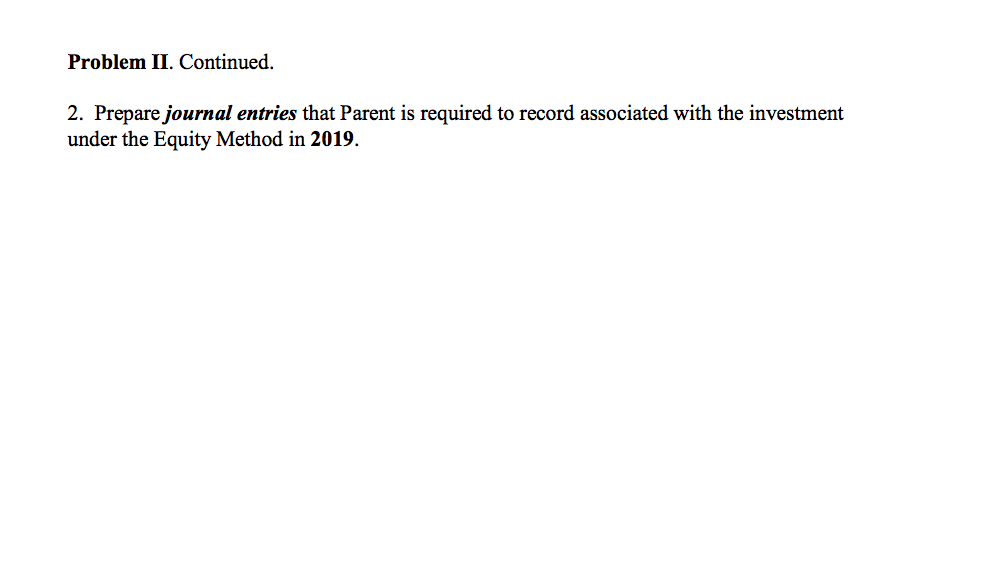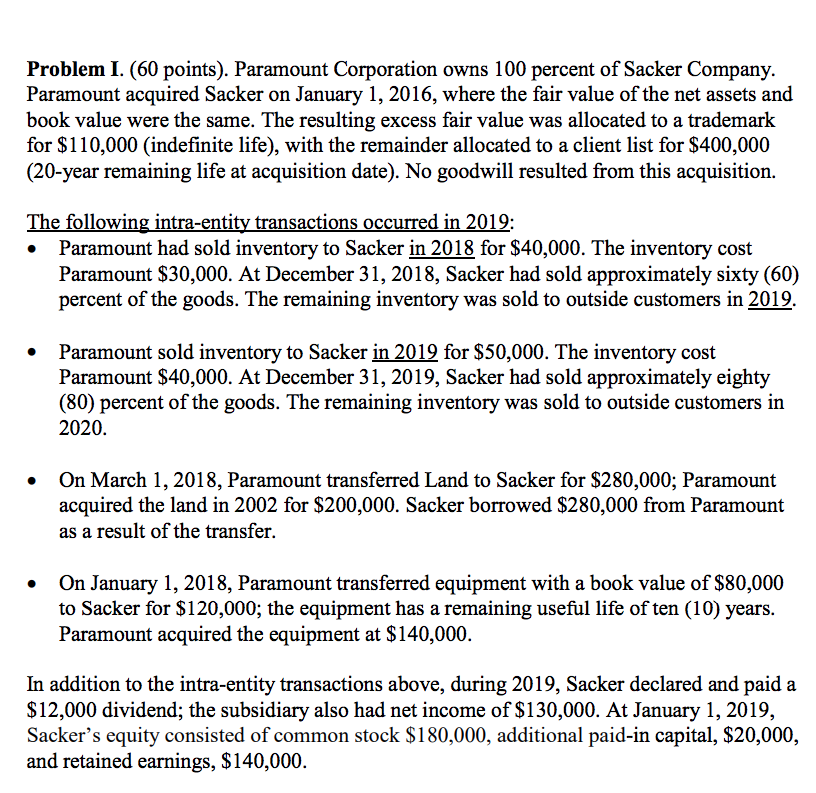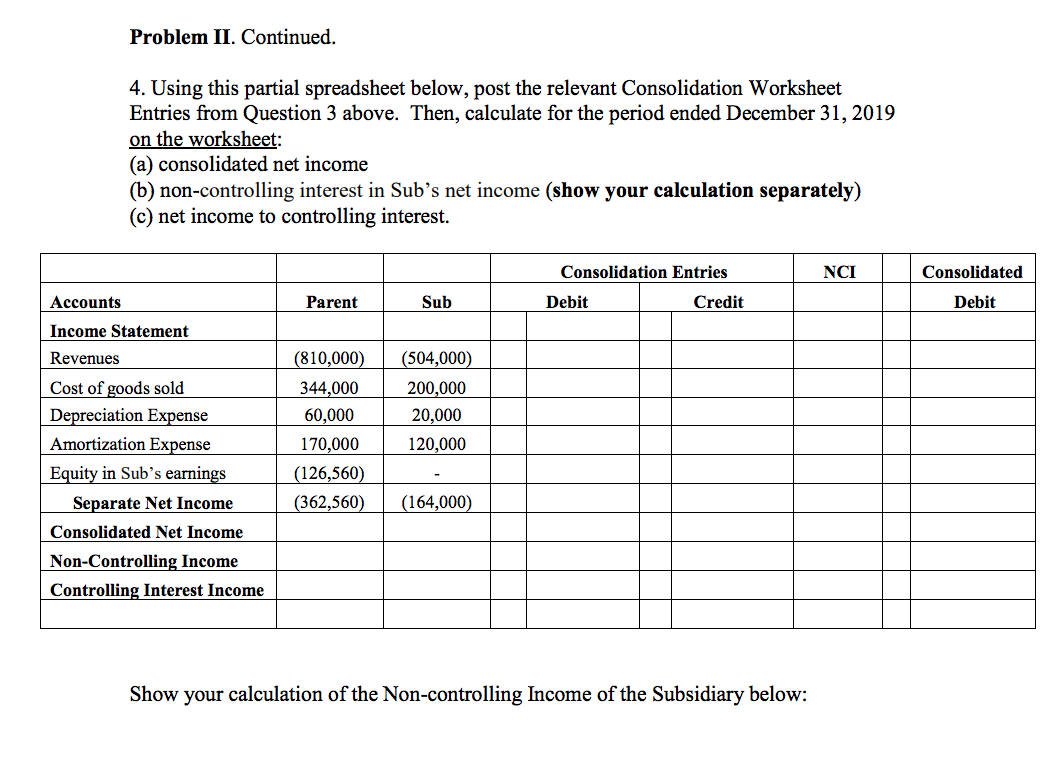

 please answer fully
please answer fully
Problem II. Continued. 2. Prepare journal entries that Parent is required to record associated with the investment under the Equity Method in 2019. Problem I. (60 points). Paramount Corporation owns 100 percent of Sacker Company. Paramount acquired Sacker on January 1, 2016, where the fair value of the net assets and book value were the same. The resulting excess fair value was allocated to a trademark for $110,000 indefinite life), with the remainder allocated to a client list for $400,000 (20-year remaining life at acquisition date). No goodwill resulted from this acquisition. The following intra-entity transactions occurred in 2019: Paramount had sold inventory to Sacker in 2018 for $40,000. The inventory cost Paramount $30,000. At December 31, 2018, Sacker had sold approximately sixty (60) percent of the goods. The remaining inventory was sold to outside customers in 2019. Paramount sold inventory to Sacker in 2019 for $50,000. The inventory cost Paramount $40,000. At December 31, 2019, Sacker had sold approximately eighty (80) percent of the goods. The remaining inventory was sold to outside customers in 2020. On March 1, 2018, Paramount transferred Land to Sacker for $280,000; Paramount acquired the land in 2002 for $200,000. Sacker borrowed $280,000 from Paramount as a result of the transfer. On January 1, 2018, Paramount transferred equipment with a book value of $80,000 to Sacker for $120,000; the equipment has a remaining useful life of ten (10) years. Paramount acquired the equipment at $140,000. In addition to the intra-entity transactions above, during 2019, Sacker declared and paid a $12,000 dividend; the subsidiary also had net income of $130,000. At January 1, 2019, Sacker's equity consisted of common stock $180,000, additional paid-in capital, $20,000, and retained earnings, $140,000. Problem II. Continued. 4. Using this partial spreadsheet below, post the relevant Consolidation Worksheet Entries from Question 3 above. Then, calculate for the period ended December 31, 2019 on the worksheet: (a) consolidated net income (b) non-controlling interest in Sub's net income (show your calculation separately) (c) net income to controlling interest. Consolidation Entries NCI Consolidated Debit Parent Sub Debit Credit Accounts Income Statement Revenues Cost of goods sold Depreciation Expense Amortization Expense Equity in Sub's earnings Separate Net Income Consolidated Net Income Non-Controlling Income Controlling Interest Income (810,000) 344,000 60,000 170,000 (126,560) (362,560) (504,000) 200,000 20,000 120,000 | (164,000) Show your calculation of the Non-controlling Income of the Subsidiary below: Problem I (60 points). Paramount Corporation owns 100 percent of Sacker Company. Paramount acquired Sacker on January 1, 2016, where the fair value of the net assets and book value were the same. The resulting excess fair value was allocated to a trademark for $110,000 (indefinite life), with the remainder allocated to a client list for $400,000 (20-year remaining life at acquisition date). No goodwill resulted from this acquisition. The following intra-entity transactions occurred in 2019: Paramount had sold inventory to Sacker in 2018 for $40,000. The inventory cost Paramount $30,000. At December 31, 2018, Sacker had sold approximately sixty (60) percent of the goods. The remaining inventory was sold to outside customers in 2019. Paramount sold inventory to Sacker in 2019 for $50,000. The inventory cost Paramount $40,000. At December 31, 2019, Sacker had sold approximately eighty (80) percent of the goods. The remaining inventory was sold to outside customers in 2020. On March 1, 2018, Paramount transferred Land to Sacker for $280,000; Paramount acquired the land in 2002 for $200,000. Sacker borrowed $280,000 from Paramount as a result of the transfer. On January 1, 2018, Paramount transferred equipment with a book value of 80,000 to Sacker for $120,000; the equipment has a remaining useful life of ten (10) years. Paramount acquired the equipment at $140,000. In addition to the intra-entity transactions above, during 2019, Sacker declared and paid a $12,000 dividend; the subsidiary also had net income of $130,000. At January 1, 2019, Sacker's equity consisted of common stock $180,000, additional paid-in capital, $20,000, and retained earnings, $140,000. Problem II. Continued. 3. Prepare the Consolidation Worksheet Entries at December 31, 2019 Consolidation Worksheet Entry S(note: Calculate Retained Earnings from 1/1/16 to 12/31/17 to derive Retained Earnings-S (1/1/19)): Consolidation Worksheet Entry A: Consolidation Worksheet Entry 1: Consolidation Worksheet Entry D: Consolidation Worksheet Entry E: Problem II. Continued. 2. Prepare journal entries that Parent is required to record associated with the investment under the Equity Method in 2019. Problem I. (60 points). Paramount Corporation owns 100 percent of Sacker Company. Paramount acquired Sacker on January 1, 2016, where the fair value of the net assets and book value were the same. The resulting excess fair value was allocated to a trademark for $110,000 indefinite life), with the remainder allocated to a client list for $400,000 (20-year remaining life at acquisition date). No goodwill resulted from this acquisition. The following intra-entity transactions occurred in 2019: Paramount had sold inventory to Sacker in 2018 for $40,000. The inventory cost Paramount $30,000. At December 31, 2018, Sacker had sold approximately sixty (60) percent of the goods. The remaining inventory was sold to outside customers in 2019. Paramount sold inventory to Sacker in 2019 for $50,000. The inventory cost Paramount $40,000. At December 31, 2019, Sacker had sold approximately eighty (80) percent of the goods. The remaining inventory was sold to outside customers in 2020. On March 1, 2018, Paramount transferred Land to Sacker for $280,000; Paramount acquired the land in 2002 for $200,000. Sacker borrowed $280,000 from Paramount as a result of the transfer. On January 1, 2018, Paramount transferred equipment with a book value of $80,000 to Sacker for $120,000; the equipment has a remaining useful life of ten (10) years. Paramount acquired the equipment at $140,000. In addition to the intra-entity transactions above, during 2019, Sacker declared and paid a $12,000 dividend; the subsidiary also had net income of $130,000. At January 1, 2019, Sacker's equity consisted of common stock $180,000, additional paid-in capital, $20,000, and retained earnings, $140,000. Problem II. Continued. 4. Using this partial spreadsheet below, post the relevant Consolidation Worksheet Entries from Question 3 above. Then, calculate for the period ended December 31, 2019 on the worksheet: (a) consolidated net income (b) non-controlling interest in Sub's net income (show your calculation separately) (c) net income to controlling interest. Consolidation Entries NCI Consolidated Debit Parent Sub Debit Credit Accounts Income Statement Revenues Cost of goods sold Depreciation Expense Amortization Expense Equity in Sub's earnings Separate Net Income Consolidated Net Income Non-Controlling Income Controlling Interest Income (810,000) 344,000 60,000 170,000 (126,560) (362,560) (504,000) 200,000 20,000 120,000 | (164,000) Show your calculation of the Non-controlling Income of the Subsidiary below: Problem I (60 points). Paramount Corporation owns 100 percent of Sacker Company. Paramount acquired Sacker on January 1, 2016, where the fair value of the net assets and book value were the same. The resulting excess fair value was allocated to a trademark for $110,000 (indefinite life), with the remainder allocated to a client list for $400,000 (20-year remaining life at acquisition date). No goodwill resulted from this acquisition. The following intra-entity transactions occurred in 2019: Paramount had sold inventory to Sacker in 2018 for $40,000. The inventory cost Paramount $30,000. At December 31, 2018, Sacker had sold approximately sixty (60) percent of the goods. The remaining inventory was sold to outside customers in 2019. Paramount sold inventory to Sacker in 2019 for $50,000. The inventory cost Paramount $40,000. At December 31, 2019, Sacker had sold approximately eighty (80) percent of the goods. The remaining inventory was sold to outside customers in 2020. On March 1, 2018, Paramount transferred Land to Sacker for $280,000; Paramount acquired the land in 2002 for $200,000. Sacker borrowed $280,000 from Paramount as a result of the transfer. On January 1, 2018, Paramount transferred equipment with a book value of 80,000 to Sacker for $120,000; the equipment has a remaining useful life of ten (10) years. Paramount acquired the equipment at $140,000. In addition to the intra-entity transactions above, during 2019, Sacker declared and paid a $12,000 dividend; the subsidiary also had net income of $130,000. At January 1, 2019, Sacker's equity consisted of common stock $180,000, additional paid-in capital, $20,000, and retained earnings, $140,000. Problem II. Continued. 3. Prepare the Consolidation Worksheet Entries at December 31, 2019 Consolidation Worksheet Entry S(note: Calculate Retained Earnings from 1/1/16 to 12/31/17 to derive Retained Earnings-S (1/1/19)): Consolidation Worksheet Entry A: Consolidation Worksheet Entry 1: Consolidation Worksheet Entry D: Consolidation Worksheet Entry E


 please answer fully
please answer fully







